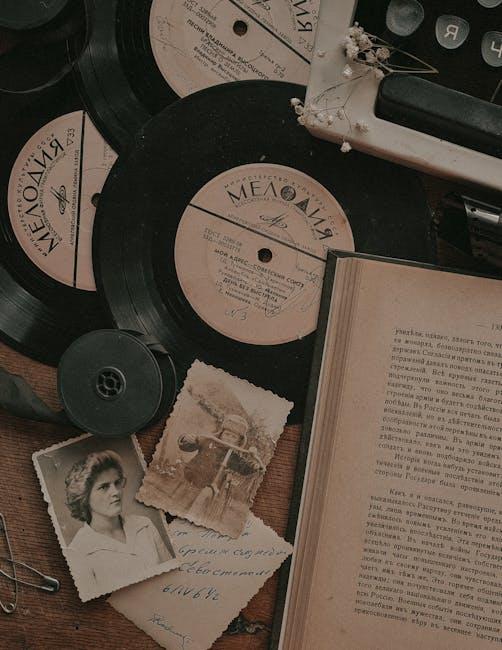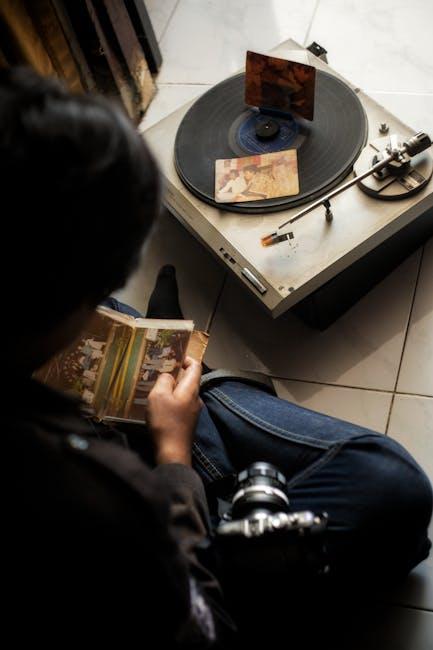In an era defined by instant gratification and relentless digital chatter, the music industry has found a bold new way to captivate audiences: the surprise album release. Without fanfare or the usual months of teasing and promotion, artists drop fully formed bodies of work, catching fans and critics alike off guard. This unexpected approach reshapes traditional marketing, challenges listeners’ expectations, and reignites the thrill of discovery in a saturated musical landscape. As we explore the rise and impact of surprise album releases, we uncover how spontaneity has become a powerful tool in an artist’s arsenal—turning moments of surprise into cultural milestones.
Table of Contents
- The Evolution of Surprise Album Drops in Music History
- The Psychological Impact of Unexpected Music Releases
- How Artists Strategically Craft Mystery and Hype
- Challenges and Risks Behind the Curtain of Surprise Launches
- Fan Reactions and Community Building in Real Time
- Best Practices for Artists Considering a Surprise Release
- Q&A
- To Wrap It Up

The Evolution of Surprise Album Drops in Music History
In an industry once dominated by carefully orchestrated marketing campaigns, surprise album drops shattered traditional norms and rewrote the rules of engagement between artists and fans. This radical approach to music releases traces back to trailblazers who understood the power of unpredictability and digital platforms. Early instances, like Radiohead’s In Rainbows “pay-what-you-want” drop in 2007, laid the groundwork, but the real game-changer came when Beyoncé silenced the world by releasing her self-titled album at midnight in 2013, without any prior announcement. This bold move harnessed digital distribution’s immediacy and demonstrated how scarcity and surprise can amplify fan excitement and social media buzz, creating a viral storm unlike any traditional rollout could achieve.
As the landscape evolved, surprise releases became a strategic tool for artists seeking to reclaim control from record labels and marketing teams. The phenomenon blossomed alongside streaming services, where instant accessibility redefined consumer habits. Today, surprise drops are used not only by pop icons but by indie artists and bands across genres, signaling a democratization of release strategies. Some iconic examples include:
- Drake’s “If You’re Reading This It’s Too Late” (2015) – Dropped without warning, dominating the charts instantly.
- Kanye West’s “The Life of Pablo” (2016) – A living album, updated post-release, challenging the notion of a finished product.
- Taylor Swift’s “Folklore” (2020) – A quiet surprise that contrasted her usual grand announcements, capturing fans’ hearts during a global pause.
| Artist | Album | Year | Impact |
|---|---|---|---|
| Radiohead | In Rainbows | 2007 | Pioneered digital surprise drop |
| Beyoncé | Beyoncé | 2013 | Massive viral success with no prior promo |
| Drake | If You’re Reading This It’s Too Late | 2015 | Chart-topping surprise release |
| Kanye West | The Life of Pablo | 2016 | Dynamic album updates post-launch |
| Taylor Swift | Folklore | 2020 | Quieter surprise during pandemic |

The Psychological Impact of Unexpected Music Releases
When an artist drops new music without warning, it triggers a complex emotional response in listeners. The suddenness can incite a surge of excitement and curiosity, akin to receiving an unexpected gift. Fans experience an intensified connection to the music because the element of surprise makes the release feel exclusive and personal. This abrupt unveiling often leads to a sense of discovery and novelty, which can heighten enjoyment and engagement compared to traditional, heavily marketed rollouts.
However, this unpredictability also introduces layers of psychological dynamics:
- Anticipation vs. Instant Gratification: Without buildup, listeners skip the anxious waiting phase, plunging directly into immediate consumption, which can alter the depth of their emotional investment.
- Social Connectivity: The shared experience of a surprise release fosters a unique community buzz, as fans collectively decode and discuss the new material in real-time.
- Cognitive Overload: The flood of unexpected content may overwhelm some listeners, making it harder to process and appreciate the work fully.
| Psychological Effect | Typical Listener Response |
|---|---|
| Excitement Surge | Heightened dopamine release, increased alertness |
| Community Buzz | Active social media discussions and sharing |
| Overwhelm Risk | Possible attention fatigue or reduced focus |

How Artists Strategically Craft Mystery and Hype
Artists cleverly ignite curiosity by revealing only cryptic hints or teasing enigmatic visuals on social media, sparking a wildfire of speculation among fans. This subtle approach turns anticipation into an interactive game, where audiences piece together clues and create theories, fostering a deeper emotional investment long before a single track drops. The suspense generated by this orchestrated ambiguity is a powerful tool, as it transforms passive listeners into active participants, eager to uncover secrets embedded in every cryptic post.
Moreover, the strategic timing of these drops is often aligned with key cultural moments or anniversaries, creating a synergy that amplifies buzz organically. Surprise elements include:
- Unexpected midnight releases that exploit global time zone differences.
- Collaboration teases without full disclosure.
- Visuals or snippets shared exclusively with select fan groups to cultivate exclusivity.
| Element | Purpose | Effect |
|---|---|---|
| Veiled Clues | Generate curiosity | Fan theories & viral buzz |
| Timed Drops | Maximize impact | Global audience engagement |
| Exclusive Access | Build loyalty | Community strengthening |

Challenges and Risks Behind the Curtain of Surprise Launches
Behind the thrill of an unexpected album drop lies a labyrinth of hurdles that artists and labels must navigate carefully. The sudden nature of these releases often means compressed production schedules and last-minute logistical challenges, from mastering tracks to distribution. Additionally, marketing teams face the paradox of promoting something that’s meant to take fans by surprise, juggling between building anticipation discreetly and ensuring the audience doesn’t feel blindsided or confused. This balancing act can sometimes lead to missed promotional opportunities or lower initial engagement compared to traditional campaigns.
Moreover, surprise drops are not without their inherent risks. If the album doesn’t immediately resonate, the artist might suffer from a lack of gradual hype and critical buildup that traditional releases enjoy. The unexpected launch can also overwhelm streaming platforms and social media channels, leading to technical glitches or diluted visibility among an influx of concurrent content. Below is a simple overview of common challenges associated with these releases:
| Challenge | Potential Risk |
|---|---|
| Compressed production timeline | Quality control issues |
| Limited promotion window | Lower initial sales/streams |
| Surprise factor management | Fan confusion or backlash |
| Platform overload | Technical problems, reduced visibility |

Fan Reactions and Community Building in Real Time
When artists drop surprise albums, the digital landscape instantly erupts with a vibrant mosaic of emotions. Fans rush to social media platforms, transforming their astonishment and excitement into a whirlwind of real-time chatter. Tweets, TikTok videos, and Instagram stories flood the feeds, creating an electrifying sense of communal discovery. This spontaneous surge of reactions — from ecstatic praise to critical breakdowns — deepens the shared listening experience, knitting a global network of listeners into a tight-knit community united by the thrill of the unexpected.
Beyond immediate reactions, these surprise drops ignite the creation of dedicated online spaces that thrive on collaboration and shared passion. Fan forums, subreddit threads, and live-streamed listening parties bloom overnight, serving as digital campfires where fans dissect lyrics, exchange interpretations, and celebrate the artistry together. This dynamic, organic community-building process exemplifies how music’s impact extends far beyond the tracks themselves, forging cultural moments through collective engagement.
- Instant global dialogue: Fans connect across time zones as reactions pour in simultaneously.
- User-generated content: Memes and fan art proliferate, fueling further interaction.
- Dynamic fan spaces: Online groups evolve quickly to facilitate new music discussions.
| Platform | Reaction Type | Community Impact |
|---|---|---|
| Instant Buzz & Viral Hashtags | Unites fanbase with trending conversations | |
| In-Depth Analysis & Theories | Fosters thoughtful community debates | |
| TikTok | Creative Covers & Challenges | Boosts viral trends and fan creativity |

Best Practices for Artists Considering a Surprise Release
When planning a surprise drop, artists should focus heavily on the element of unpredictability while ensuring their audience remains engaged. One effective tactic is to leverage subtle teasers without giving away the full scope of the release. This could include enigmatic social media posts, cryptic artwork snippets, or mysterious countdowns that spark curiosity without unveiling too much. Additionally, collaborating with a trusted team to quietly prepare all marketing and distribution channels ahead of time is crucial to avoid technical hiccups and to guarantee that the release reaches listeners seamlessly once it goes live.
Success hinges on understanding how to balance secrecy with accessibility. Here are some key strategies to keep in mind:
- Prepare your digital platforms: Ensure stores, streaming services, and websites are ready for instant updates.
- Build hype quietly: Use enigmatic posts and private listening events before the drop.
- Engage core fans first: Reward loyal listeners through exclusive previews or early access via mailing lists.
- Coordinate press and influencers: Have reviews and promotions timed perfectly to launch alongside the album.
| Consideration | Impact |
|---|---|
| Teaser Strategy | Builds anticipation without spoiling surprise |
| Pre-release Testing | Ensures flawless technical execution |
| Fan Engagement | Turns early buzz into lasting loyalty |
Q&A
Q&A: The Phenomenon of
Q: What exactly is a surprise album release?
A: A surprise album release is when an artist drops a new album with little to no prior announcement or traditional promotional build-up. Instead of teasing singles or sharing release dates weeks in advance, the album appears suddenly, often generating immediate buzz and excitement.
Q: Why do artists choose to release albums without warning?
A: Artists may opt for surprise releases to break away from the predictable marketing cycle, create a moment of genuine shock and delight for fans, and command attention in an oversaturated music landscape. It can also help combat leaks and maintain creative control over how and when the music is heard.
Q: Can you give examples of famous surprise album drops?
A: Certainly! Beyoncé’s self-titled 2013 album is a landmark example—no prior announcement, a visual album, and an instant cultural event. Other notable drop surprises include Radiohead’s “In Rainbows” with its pay-what-you-want model, and Taylor Swift’s “Folklore,” which debuted in the middle of the 2020 pandemic lockdown.
Q: How do surprise releases impact fans and the music industry?
A: Fans often experience a wave of exhilaration and curiosity, as the unexpected nature creates a shared experience of discovery. For the industry, it challenges traditional release strategies and promotional schedules, forcing critics, media, and streaming services to adapt quickly to sudden shifts.
Q: Are surprise releases better or worse than traditional rollouts?
A: Neither approach is inherently better—each has its strengths. Traditional rollouts build anticipation and allow for sustained marketing. Surprise releases deliver immediacy and freshness. The choice depends on the artist’s vision, audience, and the creative story they want to tell.
Q: Will the trend of surprise albums continue to grow?
A: As streaming platforms evolve and artists seek new ways to connect with listeners, surprise releases are likely to remain a compelling tactic. However, because music consumption varies widely, artists will probably continue mixing surprise drops with more conventional promotions to best suit their unique goals.
Q: What should listeners keep in mind when reacting to a surprise release?
A: Embrace the moment! Surprise albums encourage fans to engage with music in real time, beyond the hype machine. Listeners can focus on experiencing the art fresh, forming opinions without preconceived notions, and appreciating the spontaneity that keeps music culture vibrant.
To Wrap It Up
In the end, surprise album releases continue to reshape the landscape of music, challenging traditional norms and captivating audiences with their unpredictability. Whether born from a spark of spontaneous creativity or a strategic move to ignite fan excitement, these unexpected drops remind us that in music, as in life, the thrill often lies in the unexpected. As artists and listeners alike embrace the element of surprise, one thing remains certain: the next drop may be just around the corner, ready to change the rhythm of our days.

